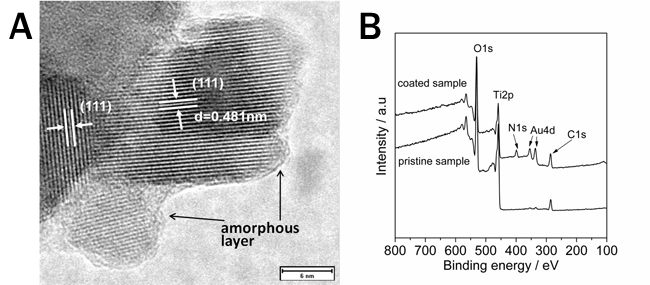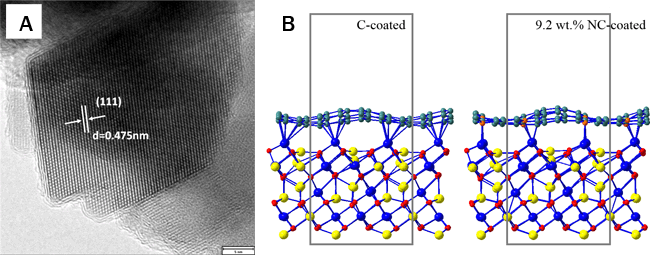Among all the electrochemical energy storage devices, lithium ion battery, due to its high energy density, high power density, has been widely used in portable electronic devices, and has also been proposed for use in electric vehicles and large-scale energy storage. Spinel Li
4Ti
5O
12 has attracted great interest as a new anode material for lithium ion battery. Its relatively high lithiation voltage plateau at 1.54V (versus Li/Li
+) can avoid the safety concern and the small volume change during lithium insertion/extraction ensures its potential excellent cycling performance. However, its low electronic conductivity hinders its use in high power battery; and the gas-release (package swelling) problem resulting from the surface catalytic reaction between active material and electrolyte degrades the performance and causes safety concern. Surface carbon-coating is an effective approach to solve these problems, but it is still a big challenge to obtain uniform-thickness coating layer with high electric conductivity at relatively low temperature.
Recently, PhD student Liang Zhao and Prof. Yong-Sheng Hu et al. in Group E01 from the Institute of Physics, CAS/Beijing National Laboratory for Condensed Matter Physics proposed a new carbon-coating technique for electrode materials using nitrogen-containing ionic liquids (ILs) as precursor. The porous Li
4Ti
5O
12 uniformly coated with 1-2nm thickness of nitrogen-doped carbon shows excellent cycling performance (with a capacity retention of 83% after 2200 cycles in a half cell) and high rate capability (129 mAh/g at 10C discharge/charge rate with a capacity retention of 80%, 10C means full charge/discharge in 6 min). The advantages of this coating technique include: there is no solvent evaporation during the pyrolysis process for ionic liquids, which is favorable for the formation of uniform coating layer; it is easy to adjust the configuration and content of nitrogen in carbon by choosing various anions and cations of ILs; this technique can be extended to the surface modification of other electrode materials. This work has been published in Adv. Mater., 23, 1385-1388, 2011.
In order to make clear the effects of carbon and nitrogen-doped carbon coating on electrochemical performance of Li
4Ti
5O
12, we collaborate with PhD student Zijing Ding and Prof. Sheng Meng in Group SF5. For the first time, using first-principles calculations based density functional theory, we construct an atomistic model for the interface between lithium transition metal oxide and carbon coating layers and obtain the physical picture of charge transfer process at the interface. The results show that at this interface there is a strong binding between the graphene coating layer and the Ti-terminated LTO surface, which significantly reduces the chemical activity of LTO surfaces and stabilizes the electrode/electrolyte interface, providing a clue to solve the gas-release problem for LTO-based batteries. This work has been published in Phys. Chem. Chem. Phys., 13, 15127-15133, 2011.
The above work was supported by funding from the “863” Project (2009AA033101), “973” Projects (2007CB936500), NSFC (50972164) and CAS project (KJCX2-YW-W26).
 |
| Fig.1 Characterization results of the nitrogen-doped carbon-coated Li4Ti5O12: (A) HRTEM image. A uniform coating layer formed on the particle surface; (B) XPS of the pristine and coated samples. Nitrogen element can be detected for the coated sample. (Image by Yong-Sheng Hu et al.) |
 |
| Fig. 2 Rate capability (A) and cycling performance (B) of the nitrogen-doped carbon-coated Li4Ti5O12compared with the pristine Li4Ti5O12. (Image by Yong-Sheng Hu et al.) |
 |
| Fig. 3 (A) HRTEM image of carbon-coated Li4Ti5O12by a CVD method. There is 1-2 graphene coating layer on the particle surface; (B) Side view of graphene or N-doped graphene-Li4Ti5O12interface model. The surface of Li4Ti5O12is Ti-terminated. (Image by Yong-Sheng Hu et al.) |
The link for the papers:
1.“Porous Li
4Ti
5O
12 Coated with N-Doped Carbon from Ionic Liquids for Li-Ion Batteries”
http://onlinelibrary.wiley.com/doi/10.1002/adma.201003294/abstract2.“Towards understanding the effects of carbon and nitrogen-doped carbon coating on the electrochemical performance of Li
4Ti
5O
12 in lithium ion batteries: a combined experimental and theoretical study”
http://pubs.rsc.org/en/Content/ArticleLanding/2011/CP/c1cp21513b



